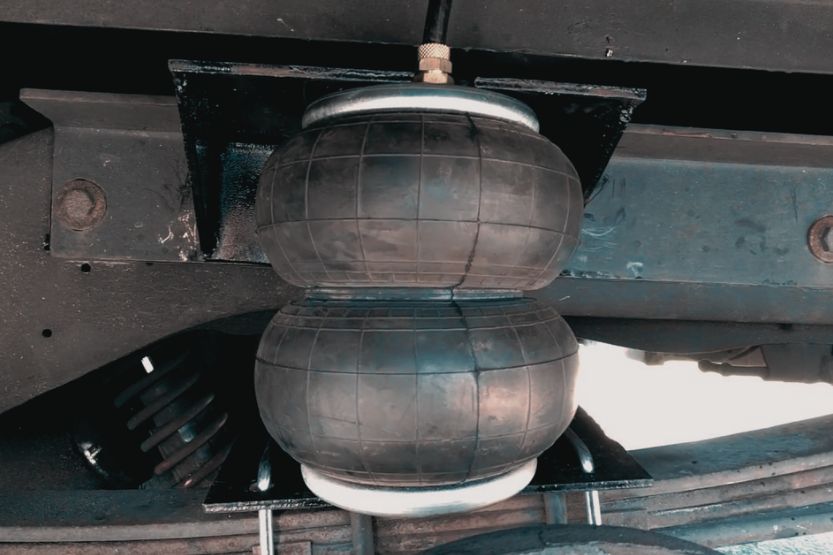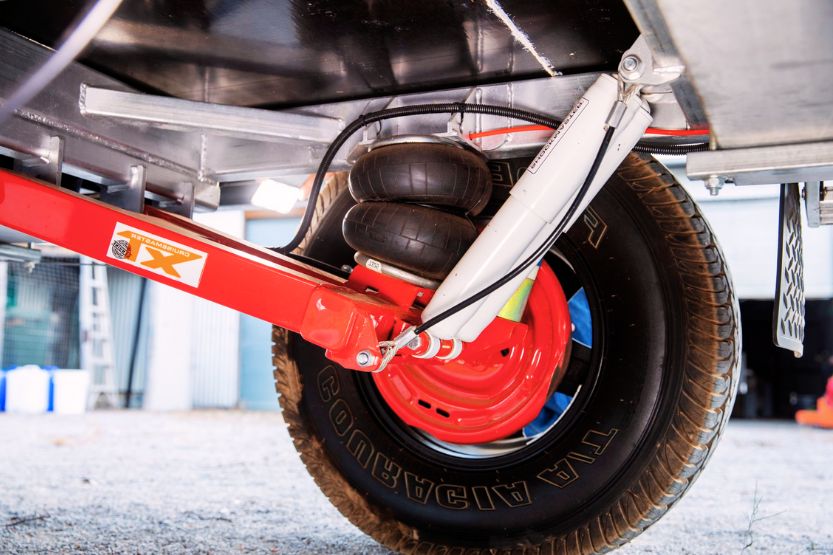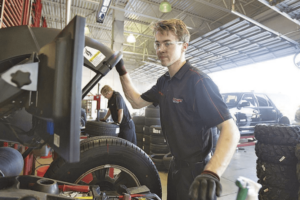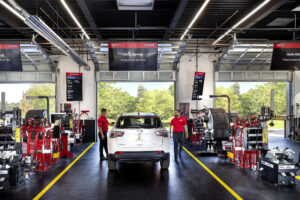Are you a newcomer to car culture? If you are, you are probably confused with the terminology, especially the bagged stance. So for starters, like you, what is a bagged stance, and what does it do for your car?
A car is “bagged,” which means sitting on top of an air suspension system. This allows the driver to raise and lower the vehicle’s ride height. Most people in the car scene would bag their cars to fit bigger wheels and tires. Another reason is to lay their vehicles as close to the pavement as possible.
Read on to learn more about the bagged stance and whether you should or should not do it to your car.
What Is Bagged Stance?

When you say a car is “bagged,” it means it is on an air suspension system. Furthermore, you can immediately raise or lower your vehicle’s ride height. You can do this even while you are on the move. This will also give you a perfect fit for bigger wheels and tires.
Adjusting the ride height of a bagged car while driving can be convenient. For instance, you can raise the air suspension if you see a speed bump.
That way, you can get over the hump quickly. Compare that to a “static” suspension lowered car. It may have to attack the speedbump at an angle so its undercarriage will not scrape the concrete.
Fans of static suspensions call airbag suspensions “the easy way out.” The reason is that they do not have to compensate for any bumps or potholes in the road.
However, airbag suspensions come with their own set of problems. This is why people with bagged stance cars beg to differ when others say they have it easy.
What Components Are Required by an Air Suspension System?
Before getting into the in-depth discussion, you should first learn about the components of an airbag suspension system:
1. Airbags Instead of Springs
Airbags still use struts like the typical suspension you find in a car. However, instead of springs, they use airbags. The standard material for the airbags is a blend of rubber and polyurethane. This makes them quite durable and resistant to punctures.
2. Air Compressor and Tank
There is also an air compressor and tank that provides the air inflating the airbags. You may notice the air pumps connected to the engine and attached to the car’s electrical system.
3. Remote Control
Most aftermarket airbag suspensions come with remote controls. There are also many newer ones that you can control using a smartphone app. However, even though there are remote controls, an airbag system will always have a hardwired switch/es inside the car.
The switch will let you lift and lower the car’s ride height whenever possible. This is possible even when the vehicle is in motion. The more air pumped into the airbags, the higher the ride height. To lower the car, the air is gradually released from the bags.
4. Airlines
The airbags, the air tank, and the compressor must connect with airlines. These airlines can help control the air going into the bags. In that case, they must first go through a manifold and control module.
5. Control Box
Most companies nowadays manufacture their control box with a display window that is quite convenient. In the old days, toggle switches were around to control each airbag.
How Much Does an Air Suspension Cost?
Few people run air suspensions on their rides because of the cost involved. Air suspensions are the most expensive option when it comes to suspensions. However, an air suspension is also a good option despite the price, as it is very versatile.
Depending on the brand and type of air suspension system, it will cost anywhere between $1,500 to over $5,000. Also, you can save money if you buy the components separately rather than buy an all-in-one kit. However, hunting down the individual parts can take a lot more time.
Aside from the required materials, labor costs for installing airbag suspensions can be pretty steep.
Most shops usually charge up to $125 per hour for the installation, and the job typically takes 10 hours. Therefore, installing an air bag suspension can cost you $1,250, excluding other shop fees.
Can you install the airbags yourself? Some airbag companies claim that their products are easy to install. However, the truth is that most normies do not have the skills and the tools required for the installation. Even the “bolt-on” kits that do not require invasive cutting are not that easy to install.
Benefits of Airbags Suspension
Depending on what you are looking for, airbag suspension might be the perfect system for you. If you need further convincing, here are a couple of the biggest benefits of using this suspension system:
1. A More Comfortable Ride
Compared to coil-over springs, airbags provide significantly better road shock dampening. The airbags can absorb the vibrations and bumps from the road.
In other words, they can provide a more comfortable ride. Most cargo trucks ride on airbags. This is a huge benefit for drivers because they typically have to be on the road most of the day.
Aside from road shocks, the airbags also dampen the noise from the tire treads hitting the pavement. Even with the radio off, you will not hear too much noise inside the cab of your car.
2. Lowers Wear and Tear
The airbags absorb most of the road shocks. The other suspension system components do not have to do that function. Your suspension system can last much longer than when you still use coil-over springs.
Do you own a travel trailer? Then setting it up with an airbag suspension will add a couple more years to its lifespan.
The system will prevent your trailer from being subjected to as much road stress as before. This makes its components last much longer compared to when it was still using the stock leaf springs.
3. Reduces the Chances of Bouncing Over Rough Terrain
Do you like to go off-roading? Does it cause your truck to bounce too much over rough terrain? Then having airbags can help prevent that from happening.
If you have a truck with a short wheelbase, it may bounce upon hitting a rough patch at speed. This is especially true if you did not load it. Coil-over springs will bounce back while airbags dampen and absorb the shock.
4. Allows Ride Height Adjustments Based on Your Load
Do you often haul heavy loads over long distances? Then, an airbag suspension will provide your vehicle with a consistent ride height.
For instance, if fully loaded, you can increase the height of the rear wheels to keep the truck level. After unloading, you can lower the airbags to their normal height.
5. Provides the Option to Adjust the Suspension Quickly
One great advantage of having an airbag suspension is that you can immediately adjust your ride’s feel. For instance, if coasting down the interstate, you can lower your suspension, so your car can “hug” the road.
This will make the ride more comfortable and smoother because the wind will not get underneath the car.
Meanwhile, if you will be going over somewhat rough country roads, you can raise your airbags. This provides your suspension with more travel, preventing the shocks from bottoming out. Raising the airbags will also increase the ride height. When you hit a bump, you will not scrape the undercarriage.
6. Makes the Car Look Good
Let’s be honest for a minute. The reason why you are planning to get airbags is that they make your car look good. If you are like most gearheads, you probably love how a car looks when “slammed.” This means the body gets lowered so much that it almost touches the ground.
Now, after showing off your slammed ride, you can raise the airbags so you can drive your car as usual.
Again, how do bagged cars work? A bagged car is on air suspension, so you can quickly adjust its ride height. Other benefits of a bagged car include perfect wheel fitment, fender-to-lip fitment, and more.
Disadvantages of Airbag Suspensions

There are also a few disadvantages to airbag suspensions. The most common ones are the following:
1. High Initial Costs
Air suspensions are notoriously expensive. Even the price of a base aftermarket airbag system will get you a nice set of coil-over springs. In addition, installation can be pretty expensive, often costing more than $100 per hour. You need to save up if you are keen on getting a set.
2. Increases Fuel Consumption
An airbag system is significantly heavier compared to leaf springs and coil overs. The main reason is that you will carry an additional air tank and compressor.
With all that additional weight, it will mean that your fuel mileage will also significantly go down. The reason is your engine will have to work harder.
Speaking of the compressor, your car will also be using additional fuel. That way, it can constantly operate the air compressor.
3. Vulnerable to Serious Malfunctions
Despite improving quite a lot through the years, air suspension systems are still not as durable as static suspensions. Some of the common issues that lead to its serious malfunction include:
Rust/Moisture Damage
Moisture can accumulate inside the airbags. The corrosion can weaken the material, causing damage that further results in malfunctioning air struts or bags.
Loose Tubing
You may be extra careful during installation because the airbag system’s tubing handles strong air pressure.
Despite that, there is still a chance for the connections to loosen. When the connections fail, the bags and struts will fail, too. Also, infrequent use can cause the connections to loosen.
Compressor Malfunction
The air compressor that feeds air into the bags can also fail. It could be when the bags have some damage and slowly leak air. The compressor will be working and running non-stop to keep the air pressure in the bags constant. This may cause the motor to burn out eventually.
Is Airbag Suspension Ideal for a Daily Driver?
We need to break this answer into two: when you are driving in the summer and the winter.
Summer
You will have no issues driving in your bagged car during the warm late spring and summer months. This is the season when the airbag suspension excels. During these warmer months, you can move your vehicle daily. In most cases, you can even drop the car.
Winter
Driving a bagged car can get tricky during the colder parts of the year. First, you must constantly check the airbag system’s components, especially the air tank.
Make sure to have a moisture trap for your air tank and that you are using some antifreeze. You do not want water in your airbags, which could cause severe damage.
Also, check that all airlines are secure and that nothing is dangling underneath the car. You would not want the airline snagging on a chunk of ice and getting ripped off.
Frequently Asked Questions (FAQs)

Does Having Airbag Suspension Improve Ride Quality?
This is a tricky question; the answer will depend on where you compare the airbag suspension. When compared to coil-over springs, there is no doubt that airbags give a much more comfortable ride. If you compare it to stock springs, the airbags will also be more comfortable.
However, herein lies the rub. If you install airbags, those may not be the only things you would modify. Most likely, you will replace the stock wheels of your car. If you do this, it will negate the additional comfort brought by the airbag suspension.
Is an Airbag Suspension Good for Racing?
Some professional racecar drivers and even some drift drivers use airbag-equipped cars. However, most professional race teams use static suspensions on their cars. The reason is that they are more reliable and less likely to fail during racing.
Coil overs are also stiffer and less likely to rebound when taking hard corners. In terms of handling, static suspensions are better. This means that springs are more predictable, thus making them the more popular choice for racing.
Also, you must be very careful when installing an airbag suspension on a racecar. Make sure to secure the myriad of air hoses under the car. If even one of these critical components hangs out, it could snag on the pavement.
Do Airbags Need Frequent Maintenance?
Yes, but they are not that complicated to maintain at all. Drivers should empty the air tanks monthly.
This is necessary to ensure that the system works as intended. Also, remove any water that penetrated the tanks and bags while emptying the air tank.
Are Airbag Suspensions Illegal?
Technically speaking, airbags are illegal. However, at the same time, they aren’t. Confusing, isn’t it?
According to the DOT, airbags are not among the approved modifications you can make to a road car. This makes airbags technically illegal. However, it is also unlawful to have dark-tinted windows and lifted trucks.
No cop will pull you over for having an airbag suspension. What if you are caught speeding, and the cop sees your air tank at the back of your car? Will this result in an automatic impound? The answer is no.
Airbags are only illegal on paper but using them is not an automatic violation when you are on the street.
Should You Choose Airbags Over Coil Overs?
Both suspension options are good, so choose based on your desired outcome. Do you want to get rid of an unsightly wheel gap?
Do you like to spend your weekends at the race track? Are you interested in something low-maintenance? If your answer to these questions is “yes, ” choose coil overs.
Do you want the ability to change the ride height on the fly? Or prefer to “air out” and slam your ride almost to the ground? Then choose airbag suspension. Yes, airbags are primarily for aesthetics, especially for road cars. However, that does not mean they are not functional.
In Closing – Bagged Car Explained
A car is “bagged” if it sits on an airbag suspension system. Unlike “static” suspensions, airbags give the driver the luxury of raising and lowering the vehicle’s ride height. You can do that even when on the move.
Typically, you can use airbags for aesthetic purposes. It lets you fit larger wheels without them hitting the wheel well. It also allows to “slam” the cars close to the ground.
Although airbag suspensions look great, they do have a couple of drawbacks. One is the high initial cost involved—however, the convenience and fun provided by this suspension system more than make up for the price.



![What Are the Gauges in a Car? [Car Gauges Explained] What Are the Gauges in a Car](https://roadsumo.com/wp-content/uploads/2021/10/what-are-the-gauges-in-a-car-150x150.jpg)
![What Is a Fender on a Car? [Fender Car Part Explained] car fender](https://roadsumo.com/wp-content/uploads/2021/07/car-fender-150x150.jpg)




